Asko WM75.1 User Manual
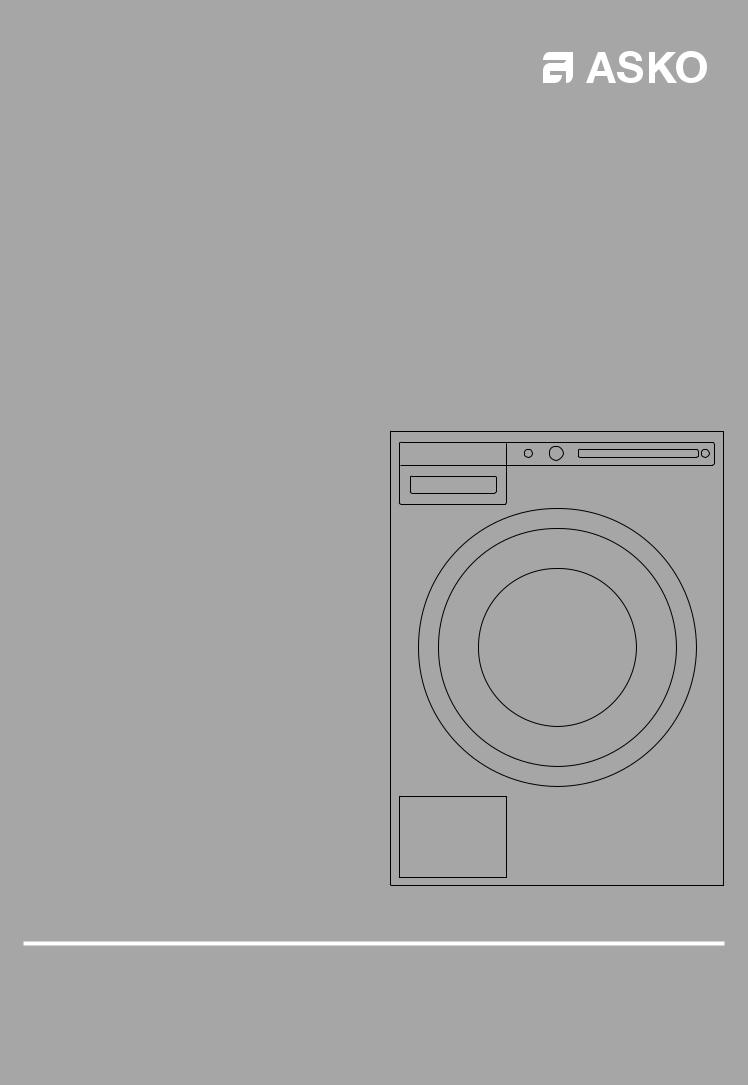
INSTRUCTIONS FOR USE |
Washing machine |
WM75.1 |
W40864C/1 |
|
Carefully read the instructions for use before using the washing machine.

Dear Customer,
We thank you for purchasing this quality ASKO product.
We hope it meets all your expectations. Scandinavian design combines pure lines, everyday functionality, and high quality. These are the key characteristics of all our products, and the reason why they are highly appreciated across the globe.
We kindly recommend you to read these instructions before using the appliance for the first time. The instruction manual also includes information on how you can help protect the environment.
TABLE OF CONTENTS
Safety precautions |
3 |
Washing machine description |
6 |
Detergent compartment |
6 |
Before using the appliance for the first time |
7 |
Installation and connection |
9 |
Tips before washing |
16 |
Washing process, step by step (1 – 8) |
18 |
System settings |
30 |
Cleaning and maintenance |
33 |
Errors – what to do? |
37 |
Service |
42 |
Technical information |
43 |
Program table |
45 |
Table: washing mode/temperature |
48 |
Table options |
49 |
Disposal |
50 |
Quick guide |
51 |
The following symbols are used throughout the manual and they have the following meanings:
Information, advice, tip, or recommendation |
Warning – danger of hot surface |
Warning – general danger |
Warning – danger of fire |
Warning – danger of electric shock |
|
Original instructions |
See Quick guide on the last page. |
2

SAFETY PRECAUTIONS
GENERAL
 Please read the instruction manual and save it for future reference.
Please read the instruction manual and save it for future reference.
•Please do not use the washing machine if you have not read and understood these instructions or use first.
•Failure to observe the instructions for use or inappropriate use of the washing machine may result in damage to the laundry or machine, or injury to the user. Keep the instruction manual handy, near the washing machine.
•Instructions for use are available on our website at www.asko.com.
•Your washing machine is intended solely for household use.
•The appliance has to be connected to the water and power supply by a trained expert.
•Any repair and maintenance pertaining to safety or performance should be done by trained experts.
•To avoid hazard, damaged power cord may only be replaced by the manufacturer, authorized service technician, or other authorized person.
•After installation, the washing machine should stand still for two hours before it is connected to the power mains.
•The washing machine may not be connected to the power mains using an extension cord.
•Do not connect the washing machine to an electrical outlet intended for an electric shaver or hair dryer.
•To connect the washing machine to water supply, make sure to use the supplied water supply hose and gaskets. Water pressure has to be between 0.1 and 1 MPa (approximately 1–10 kp/cm2, 1-10 bar, 10–100 N/cm2).
•Always use a new water supply hose to connect the appliance to water supply; do not reuse an old water supply hose.
•After the washing cycle, close the water tap and pull out the washing machine plug from the power socket.
•Only use the washing machine for washing laundry, as described in the instruction manual. The machine is not intended for dry cleaning.
•In case of incorrect appliance connection, incorrect use, or servicing by an unauthorized person, the user shall bear the cost of any damage.
•Only use detergents intended for the washing machine!
•Only use agents for machine washing and care of laundry. We shall not be responsible for any damages or discolouration of gaskets and plastic parts resulting from incorrect use of bleaching or colouring agents.
3

•Bleaches that contain chlorine can be replaced with oxygen-based bleaches. Otherwise, a neutralization cycle should be performed by running the Cotton program at the highest temperature. For best results, use hydrogen peroxide or oxygen-based detergents.
•Do not use colourants (dyes) or bleaching substances (substances for discolouration or removal of colourants) as they contain sulphuric compounds that could cause corrosion.
•Excessive use of products containing chlorine compounds increases the risk of premature failure of appliance components. This depends on the concentration of chlorine, exposure time, and temperature.
• Do not use detergents that contain solvents as this could lead to release of poisonous gases, damage to the machine, and risk of fire and explosion.
Do not use detergents that contain solvents as this could lead to release of poisonous gases, damage to the machine, and risk of fire and explosion.
•Before using the appliance for the first time, remove the transport bolts and all other transport protection devices. See chapter "BEFORE FIRST USE / Transport protection".
•The machine is not intended for use by persons (including children) with physical or mental impairments, or persons with lacking experience and knowledge. These persons should be instructed about the use of the appliance by a person responsible for their safety.
•Emergency door opening tool is located on the back side of the dispenser.
•Maximum washing capacity in kg (for the label program Standard cotton) is indicated on the rating plate (or in the PROGRAM TABLE).
CHILD SAFETY
•Do not allow small children to play with the washing machine.
•Before closing the washing machine door and running the program, make sure there is nothing except laundry in the drum (e.g. if a child climbed into the washing machine drum and closed the door from the inside).
•Keep the detergent and conditioner out of reach of children.
•Activate the child lock. See chapter "SYSTEM SETTINGS, section Child Lock".
•Do not let children younger than three years to come near the appliance, unless they are under constant supervision.
•The washing machine is made in compliance with all relevant safety standards. This washing machine may be used by children aged 8 years and above and by persons with reduced physical, sensory or mental capabilities or lack of experience and knowledge, but only if they are supervised during the use of the appliance, if they have been provided relevant instructions regarding safe use of the washing machine, and if they understand the
4

hazards of inappropriate use. Make sure children do not play with the appliance. Make sure the children do not clean the washing machine or perform any maintenance tasks without supervision.
DANGER OF HOT SURFACE 
•At higher washing temperatures, the door glass will heat up. Be careful to avoid burns. Make sure children do not play near the door glass.
WATER OVERFLOW PROTECTION 
•If the water level in the appliance rises above the normal level, then the excessive water level protection will be activated. It will shut o the water supply and start pumping out the water. If the water level does not decrease in 60 seconds, the program will be interrupted (see chapter "ERRORS – WHAT TO DO?").
TRANSPORTING / STORAGE DURING THE WINTER
If you transport or store the appliance in vehicles or rooms that are not heated and where the temperature could drop to below freezing point, please do the following:
•Clean the drain pump filter. See chapter "CLEANING AND MAINTENANCE".
•Close the water supply to the washing machine, undo the water supply hose from the water supply tap, and wait until the water flows out of the tap and the hose.
•After the drain pump filter is emptied, there can still be a small amount of water in the machine. This, however, does not a ect the quality and will not damage the appliance.
•If the washing machine is to be transported, transport protection has to be re-installed before transport (See chapter "BEFORE USING THE APPLIANCE FOR THE FIRST TIME").
SAVE THESE INSTRUCTIONS FOR FUTURE REFERENCE!
5
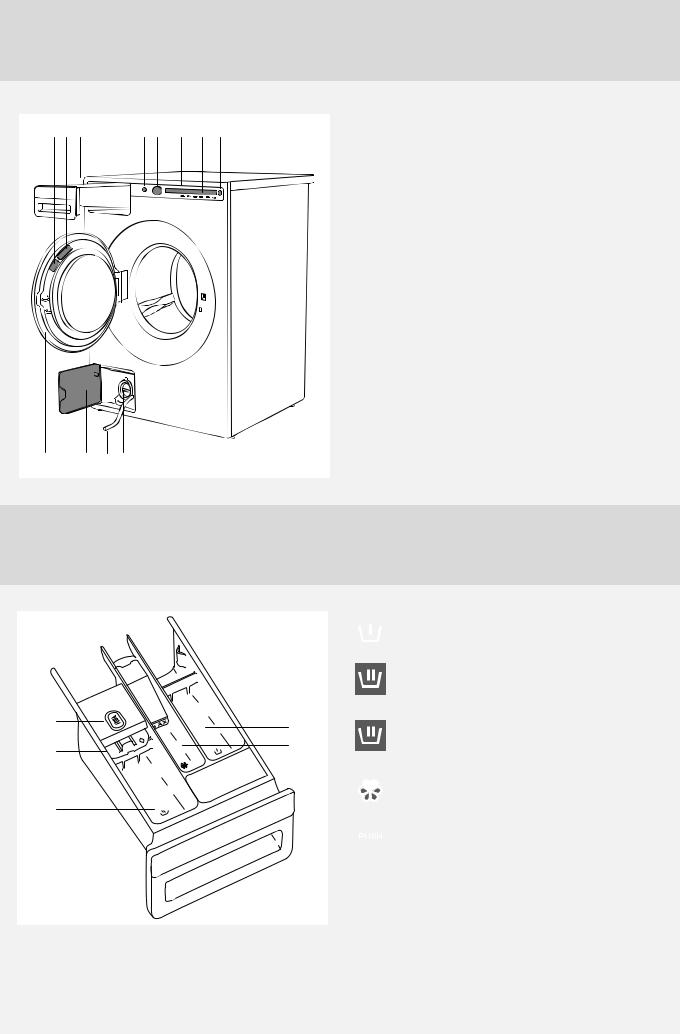
WASHING MACHINE DESCRIPTION
8 7 6 |
1 2 3 4 5 |
1. |
Main switch (ON/OFF) |
|
|
2. |
Program selector knob |
|
|
3. |
Display unit |
|
|
4. |
Program settings buttons |
|
|
5. |
Button (start/pause) |
|
|
6. |
Detergent compartment |
|
|
7. |
QR and AUID code (on the inside of the washing |
|
|
8. |
machine door) |
|
|
Rating plate with information about the washing |
|
|
|
|
machine (on the inside of the washing machine |
|
|
9. |
door) |
|
|
Washing machine door |
|
|
|
10. |
Drain filter cover |
|
|
11. |
Water release hose |
|
|
12. |
Drain filter pump (installed behind the drain |
|
|
|
pump filter) |
9 10 11 12
DETERGENT COMPARTMENT
5
1
3 |
4 |
2
 1. Prewash compartment
1. Prewash compartment
2.Compartment for main wash liquid detergent.
Use the foldable barrier (3).
2.Compartment for main wash powder detergent.
Do not use the foldable barrier (3).
 4. Softener / conditioner compartment
4. Softener / conditioner compartment
 5. Tab for detergent compartment removal
5. Tab for detergent compartment removal
6

BEFORE USING THE APPLIANCE FOR THE FIRST TIME
PACKAGING
Remove all packaging.
Please sort the materials in compliance with local recommendations (see chapter ”DISPOSAL”).
TRANSPORT PROTECTION
Before using the appliance, remove the three transport bolts and plastic plugs which protect the appliance during transport.
1 Release and remove the bolts as shown in the figures.
2 To remove the plastic plugs holding the bolts, squeeze them and then pull them out.
1 |
2 |
3 |
Remove the caps from the plastic plugs. Push the |
3 caps over the three holes in which the plastic plugs |
were inserted. Save the bolts and plastic plugs if you have to transport your washing machine in the future.

 If you wish to transport the washing machine, reinstall the bolts and plastic caps to lock the machine. This will prevent any damage to the machine due to vibrations during transport. If you have lost the transport bolts or plastic caps, replacements can be ordered at your dealer.
If you wish to transport the washing machine, reinstall the bolts and plastic caps to lock the machine. This will prevent any damage to the machine due to vibrations during transport. If you have lost the transport bolts or plastic caps, replacements can be ordered at your dealer.
Art. No. |
ID: |
270698 |
Bolt |
551188 |
Plastic cap (transport lock) |
Please order three pieces of each item!
7
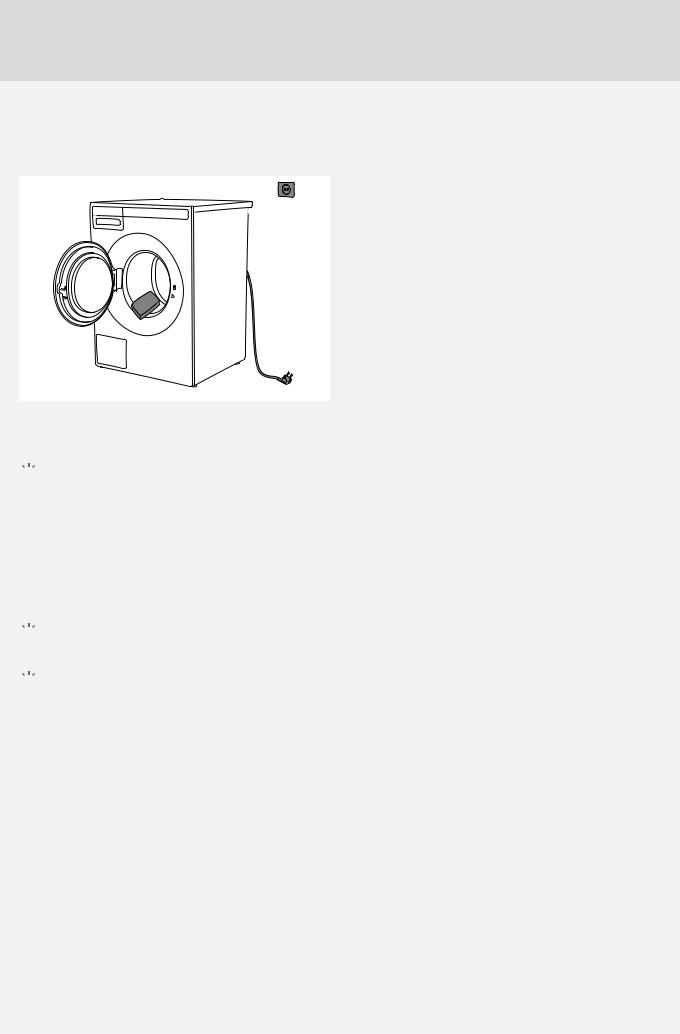
CLEANING
Disconnect the washing machine from the power mains and open the door. Clean the washing machine drum with a damp cloth and a mild detergent.
Connect the washing machine to the power mains and run the dedicated drum cleaning program. See chapter "WASHING PROCESS; STEP BY STEP (1–8)" /STEP 5: CHOOSE THE PROGRAM.

 No program can be started while the door is open.
No program can be started while the door is open.
SETTINGS BEFORE FIRST USE
After connecting the washing machine and power it for the first time, you will be asked to do following settings:
Language selection
Press the button 2 or the program selector knob to scroll the list of languages. Confirm your selection by pressing the OK button.

 The amount of detergent depends on the hardness of water. For details, see the detergent packaging. Please contact your local water supply company to check the water hardness in your area.
The amount of detergent depends on the hardness of water. For details, see the detergent packaging. Please contact your local water supply company to check the water hardness in your area.

 Before it dispatched from the factory, every appliance is tested.
Before it dispatched from the factory, every appliance is tested.
As a result, there may be some residual water left in the drain pump filter. This, however, does not a ect the quality and will not damage the appliance.
8
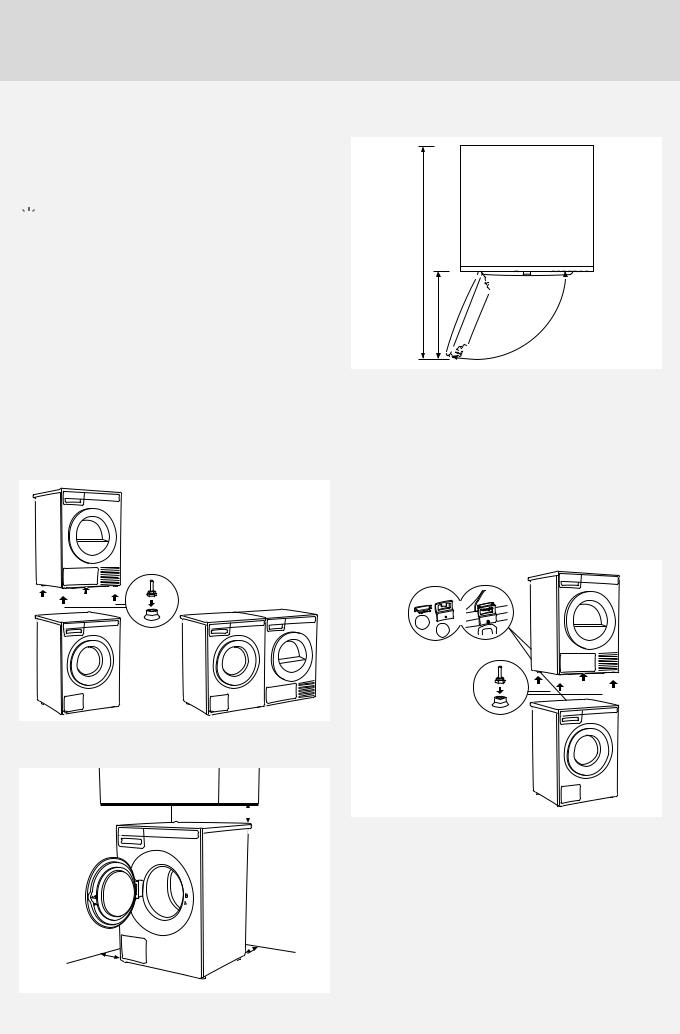
INSTALLATION AND CONNECTION
POSITIONING THE WASHING MACHINE
The washing machine can be installed as a builtin (integrated) or a free-standing unit. Place the machine on a level surface so that the power outlet on the wall is accessible.

 Before connecting the washing machine to the power mains, wait for at least 2 hours until it reaches room temperature.
Before connecting the washing machine to the power mains, wait for at least 2 hours until it reaches room temperature.
Built-in washing machine
The washing machine can be integrated under a worktop with a height of 900–950 mm. Leave 5 cm of room around the entire of the appliance, including between the back edge of the upper cover and the wall behind it.
Free-standing appliance
If you have a dryer of suitable dimensions (by another dryer manufacturer), use the vacuum feet to stack it on top of the washing machine, or place it next to it.
Clearances around the washing machine
 min. 50 mm
min. 50 mm
min. 50 mm
min. 50 mm
Opening the washing machine door (top view)
942 mm
376 mm
110°
Stacking an ASKO dryer on top of an ASKO washing machine
To stack an ASKO dryer on top of a washing machine, use the extra vacuum feet and the tipping guard (A+B), supplied in the cardboard box in the ASKO dryer drum. If the washing machine and dryer are not of matching dimensions or if you have installed a hidden helper between the two appliances, then binding plates are available as optional accessories at the service unit.
A B
9
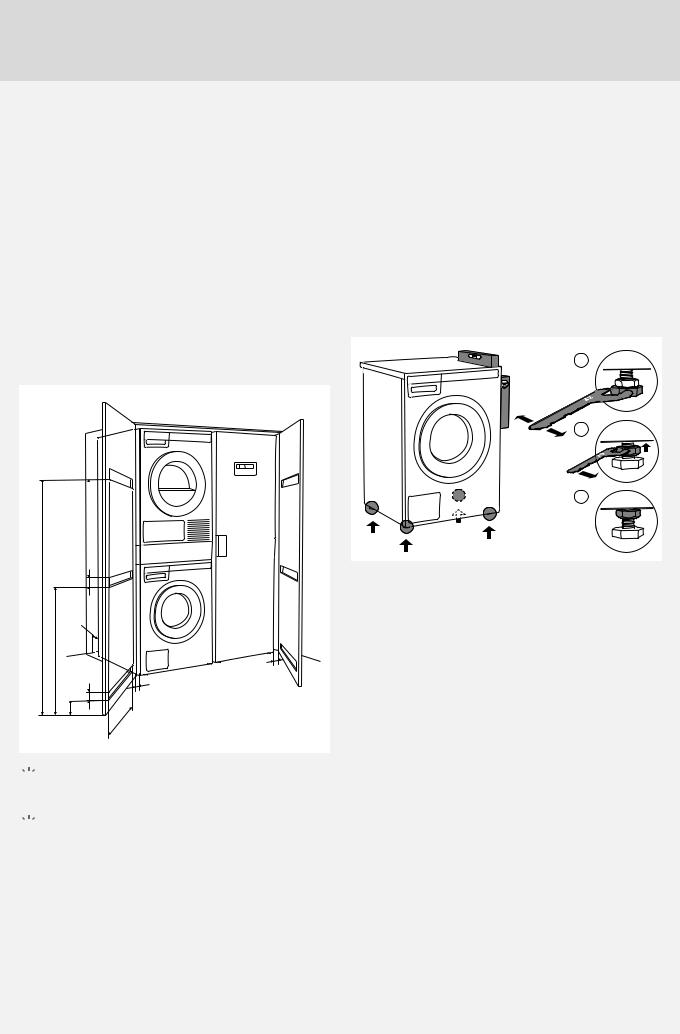
Ventilation Requirements of ASKO laundry concept or closet installation
ASKO's front panel controls make it possible to install the washers and dryers in a cabinet or closet.
Make sure there is clearance between appliances and cabinet or wall and 25 mm minimum clearance between the rear edge of the appliance top panel and the cabinet or wall.
When closet or cabinet is closed by the door, we recommend louvered doors, to ensure proper ventilation.
Otherwise there must be ventilation openings on the door. See illustration of dimension for ventilation openings below:
65 mm
mm |
50mm |
1550 |
|
25 mm |
|
635mm |
|
|
12 mm |
mm |
35mm |
|
12 mm |
65 |
|
|
465 mm |


 Ensure the dryer door can be opened without hindrance after installation.
Ensure the dryer door can be opened without hindrance after installation.


 The cool air intake panel at the front of the dryer must not be blocked or covered. Doing so could cause a fault.
The cool air intake panel at the front of the dryer must not be blocked or covered. Doing so could cause a fault.
 Disregarding of instructions influences on appliance performance and may also result in failure of the appliance.
Disregarding of instructions influences on appliance performance and may also result in failure of the appliance.
ADJUSTING THE FEET
Place the washing machine so that it is stable.
1.Level the washing machine in longitudinal and traverse direction by rotating the adjustable feet (using a No. 32 spanner).
The feet allow levelling by +/- 1 cm.
2.When the appropriate height of feet is set, use the wrench No. 17 to firmly fasten the counter-nuts towards the bottom of the appliance  .
.
3.Tighten the jam nuts (counter nuts) to the end position.
This will reduce washing machine noise, vibration, movement etc. to minimum.
1
2
3
10
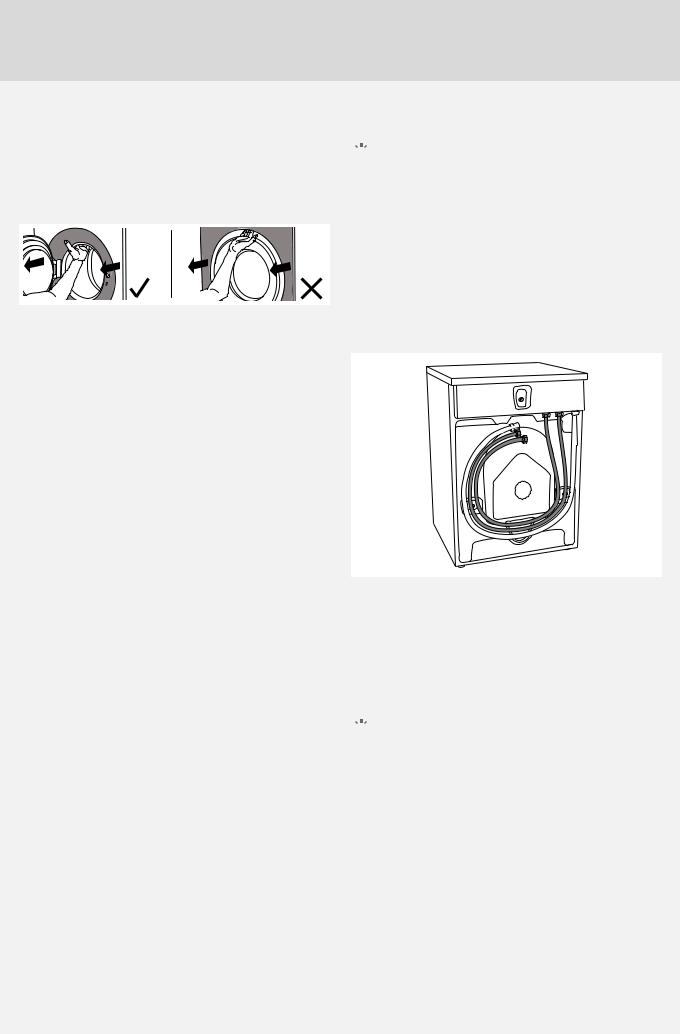
MOVING THE WASHING MACHINE AND TRANSPORT AFTER INSTALLATION
If you are moving the washing machine without packaging, open the washing machine door and pull the appliance by holding the washing assembly, as indicated in the figure.
For any further moving of the appliance, use the transport rods (the washing machine drum has to be blocked).
(See chapter TRANSPORT PROTECTION.)
CONNECTING TO WATER SUPPLY

 The machine has to be connected to water supply by an adequately trained person.
The machine has to be connected to water supply by an adequately trained person.
Use the water supply hose to connect the appliance. Water pressure has to be between 0.1 and 1 MPa (approximately 1–10 kp/cm2 , 1-10 bar, 10–100 N/ cm2).
If the hoses are newly installed, we recommend rinsing them to remove any impurities. Otherwise, these impurities could clog the filter in the water connection on the washing machine and thus cut o the water supply.
The water intake hose has to be fastened firmly enough for the hose to have a good seal.
After connecting the hose, the seal must be checked for any leaks.
Only use the water supply hose supplied with the appliance. Do not use any used or other hoses.

 If the connection on the supply hose is of di erent dimensions than the water tap (e.g. 3/4” → 1/2”), use an adapter.
If the connection on the supply hose is of di erent dimensions than the water tap (e.g. 3/4” → 1/2”), use an adapter.
11
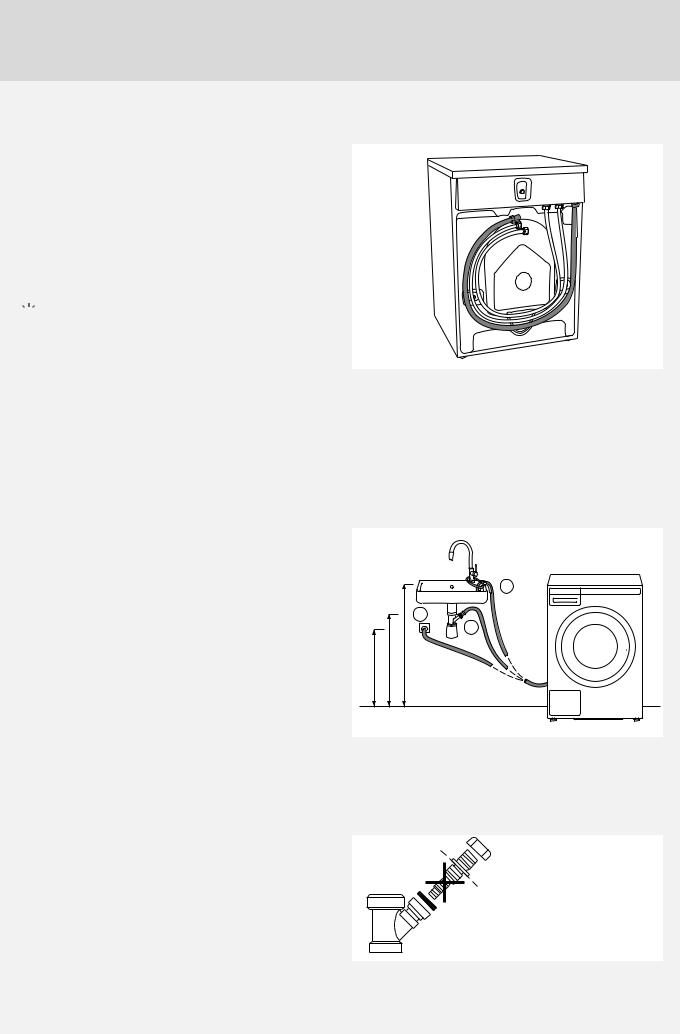
CONNECTING TO HOT/COLD WATER SUPPLY
(Only available in some models)
If your appliance has connections for both hot and cold water, then connect one hose to the cold water connection and the other hose to the hot water connection, as indicated on the back of the appliance:
COLD = cold and HOT = hot.
Hot water is supplied for programs operating at 40 °C or more.

 Connecting to both hot and cold water will save time and electric energy when washing.
Connecting to both hot and cold water will save time and electric energy when washing.
If your washing machine model has connections for both hot and cold water, and you only wish to
connect cold water, then the protective cap has to be (or remain) attached to the hot water connection.
INSTALLING THE DRAIN HOSE
Upon delivery, the appliance has a drain hose attached. This drain hose must be connected to a drain. Drain hose can also be attached to a wall drain with a trap; such trap should be properly installed to allow cleaning. The height of the drain
should be 600–900 mm above the floor. The lower position (600 mm) is always recommended. Make sure the drain hose is not clipped or bent.
A
C
B
600 - 900 mm |
600 - 900 mm |
600 - 900 mm |
Drain hose can also be connected directly to the washbasin drain via a siphon. In this case, the hose, should be 600–900 mm above the floor. Internal hose diameter should be at least 18 mm.
See figure.
At least 18 mm
12

CONNECTING TO THE POWER MAINS
 After installation, the washing machine should stand still for two hours before it is connected to the power mains.
After installation, the washing machine should stand still for two hours before it is connected to the power mains.
Connect the appliance to an earthed power outlet. After installation, the wall outlet should be freely accessible. The outlet should be fitted with an earth contact (in compliance with the relevant regulations).
Connection upon delivery
TYPE: WMXX.XXXXX MODEL: XXXXXX.X
Art.No.: XXXXXX/XX Ser.No.: XXXXXXXX
X kg
XXX-XXX V ~ XXXX W  XXA
XXA
IPX4 XX Hz 
 XX-X MPa
XX-X MPa
Information about your washing machine is indicated on the rating (type) plate.
Use the type A di erential current protection switch.
 We recommend using over-voltage protection to protect the appliance in case of a lightning strike.
We recommend using over-voltage protection to protect the appliance in case of a lightning strike.
 The washing machine may not be connected to the power mains using an extension cord.
The washing machine may not be connected to the power mains using an extension cord.

 Do not connect the washing machine to an electrical outlet intended for an electric shaver or hair dryer.
Do not connect the washing machine to an electrical outlet intended for an electric shaver or hair dryer.

 Any repair and maintenance pertaining to safety or performance should be done by trained experts.
Any repair and maintenance pertaining to safety or performance should be done by trained experts.
13
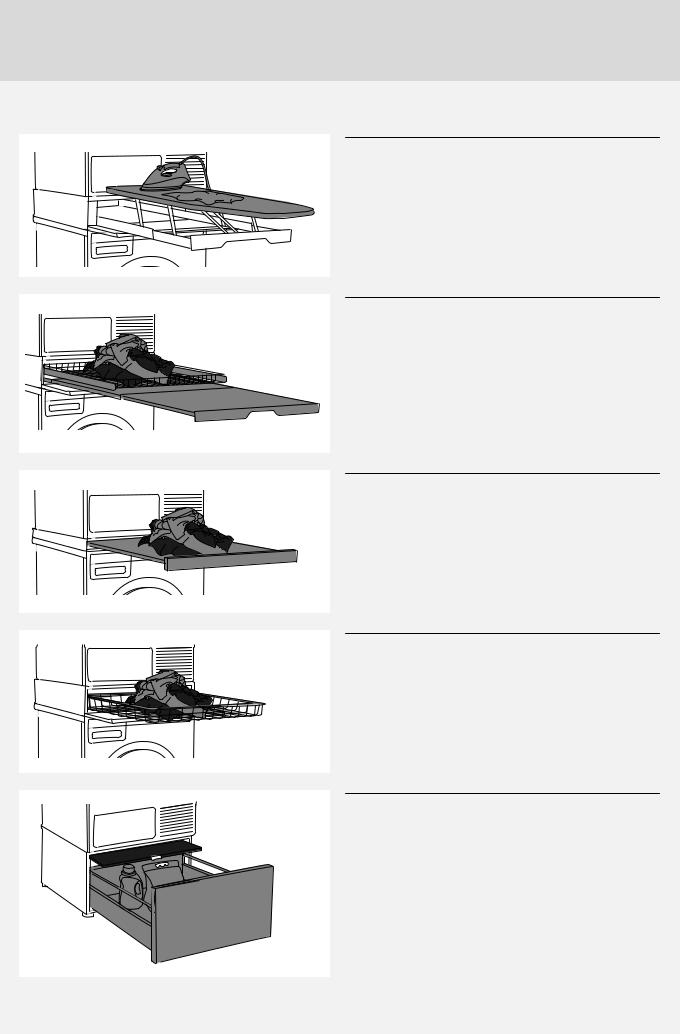
ASKO LAUNDRY CARE - HIDDEN HELPERS*
Laundry care ironing board
The ironing board is a clever solution. It is always handy when you need to iron your clothes, and it can be easily, safely and invisibly stored away when not in use.
It can be installed between your washer and dryer, or on top of one of them.
Laundry care double
A wire basket and pull-out shelf. It can be used as an additional surface for folding clothes, sorting socks and for storage. The basket is useful for removing and carrying laundry to the wardrobe or workbench for ironing and folding.
It can be installed between your washer and dryer, or on top of one of them.
Laundry care single
Pull-out shelf. It can be used as an additional surface when folding clothes and sorting socks or for storage. It also makes loading and unloading your laundry much easier.
It can be installed between your washer and dryer.
Laundry care basket
A large pull-out basket that is easily accessible via a push-pull door opening. Useful for removing laundry and carrying it to the wardrobe or workbench for ironing and folding.
It can be installed between your washer and dryer, or on top of one of them.
Pedestal drawer with shelf
A useful storage drawer with a height of 30 cm. Ideal for storing your detergent, softener, coat hangers, pegs, user manuals and other useful items in the laundry area. The drawer also comes with a shelf for easy loading and unloading of your laundry.
14
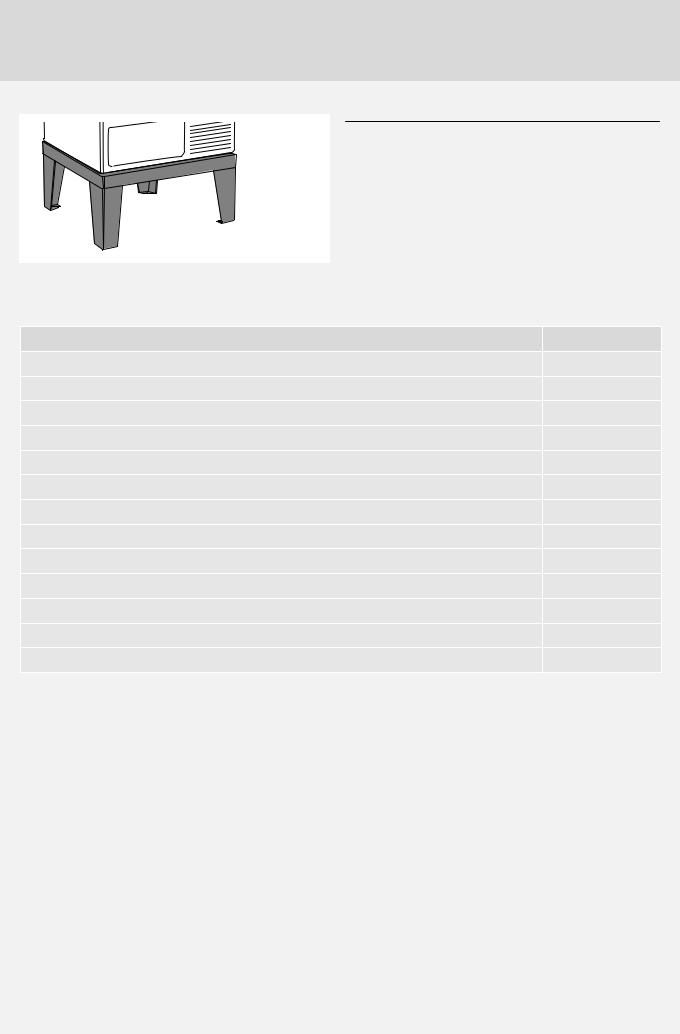
Laundry care plinth
Thanks to the stainless steel plinth, your appliance will be raised by 30 cm, which makes loading and unloading of laundry easier.
*AVAILABILITY DEPENDING ON MARKET
DENOMINATION |
ART. No. |
IRONING BOARD HI1153 White |
576552 |
IRONING BOARD HI1153 Stainless steel |
732756 |
IRONING BOARD HI1153 Titanium |
576553 |
LAUNDRY CARE DOUBLE HDB1153 White |
576554 |
LAUNDRY CARE DOUBLE HDB1153 Stainless steel |
732757 |
LAUNDRY CARE DOUBLE HDB1153 Titanium |
576555 |
LAUNDRY CARE SINGLE HSS1053 White |
576730 |
LAUNDRY CARE SINGLE HSS1053 Titanium |
576732 |
LAUNDRY CARE HB1153 White |
576733 |
PEDESTAL DRAWER W. SHELF HPS5323 White (only 8 kg or 9 kg models) |
576735 |
PEDESTAL DRAWER W. SHELF HPS5323 Stainless steel (only 8 kg or 9 kg models) |
576737 |
STAINLESS STEEL PLINTH HPL530S for 8 kg and 9 kg models |
441663 |
STAINLESS STEEL PLINTH HPL830S for 11 kg and 12 kg models |
445501 |
15
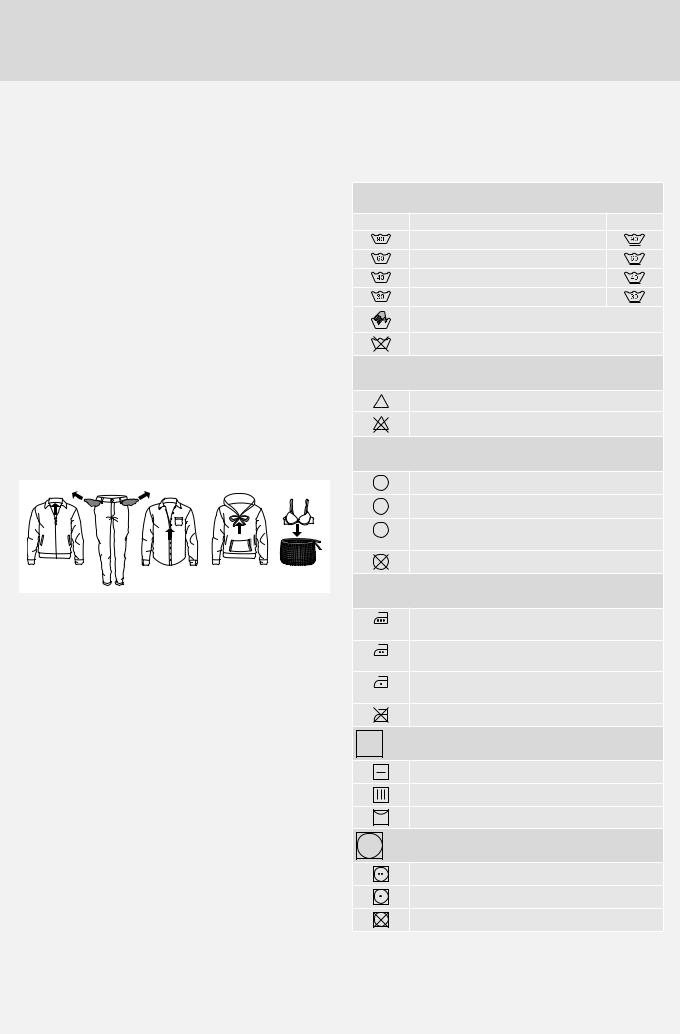
TIPS BEFORE WASHING
This chapter includes several tips on how to prepare the laundry for washing.
LAUNDRY SORTING
Sort the laundry according to:
•how soiled it is,
•colour,
•material.
CLOTHING
1.Close the zips and hook-and-loop fasteners so that they do not damage the fabric.
2.New dyed items may contain excess dye; therefore, they have to be washed separately several times.
3.Turn delicate items inside out. This will decrease the risk of tear and colour fading.
4.Place very sensitive clothes and small items in a special-purpose laundry washing bag.
5.Empty the pockets and turn them inside out.
LAUNDRY SYMBOLS
Observe the laundry symbols.
Textile maintenance symbols:
 Washing
Washing
Normal |
Delicate |
Max. washing temperature 90 °C
Max. washing temperature 60 °C
Max. washing temperature 40 °C
Max. washing temperature 30 °C
Hand wash only
Do not wash
 Bleaching
Bleaching
c1 Bleaching in cool water
Bleaching not allowed
 Dry cleaning
Dry cleaning
ADry cleaning with all agents
PPerchloroethylene R11, R113, petroleum
FDry cleaning in kerosene, pure alcohol, and R113
Dry cleaning not allowed
 Ironing
Ironing
Ironing with a hot iron with a maximum temperature of 200 °C
Ironing with a hot iron with a maximum temperature of 150°C
Ironing with a warm iron with a maximum temperature of 110°C
Ironing not allowed
Natural drying
Drying on a flat surface
Drying without prior spinning
Drying on a clothes line or a hanger
Tumble drying
Drying at high temperatures
Drying at low temperatures
Tumble drying not allowed
16
